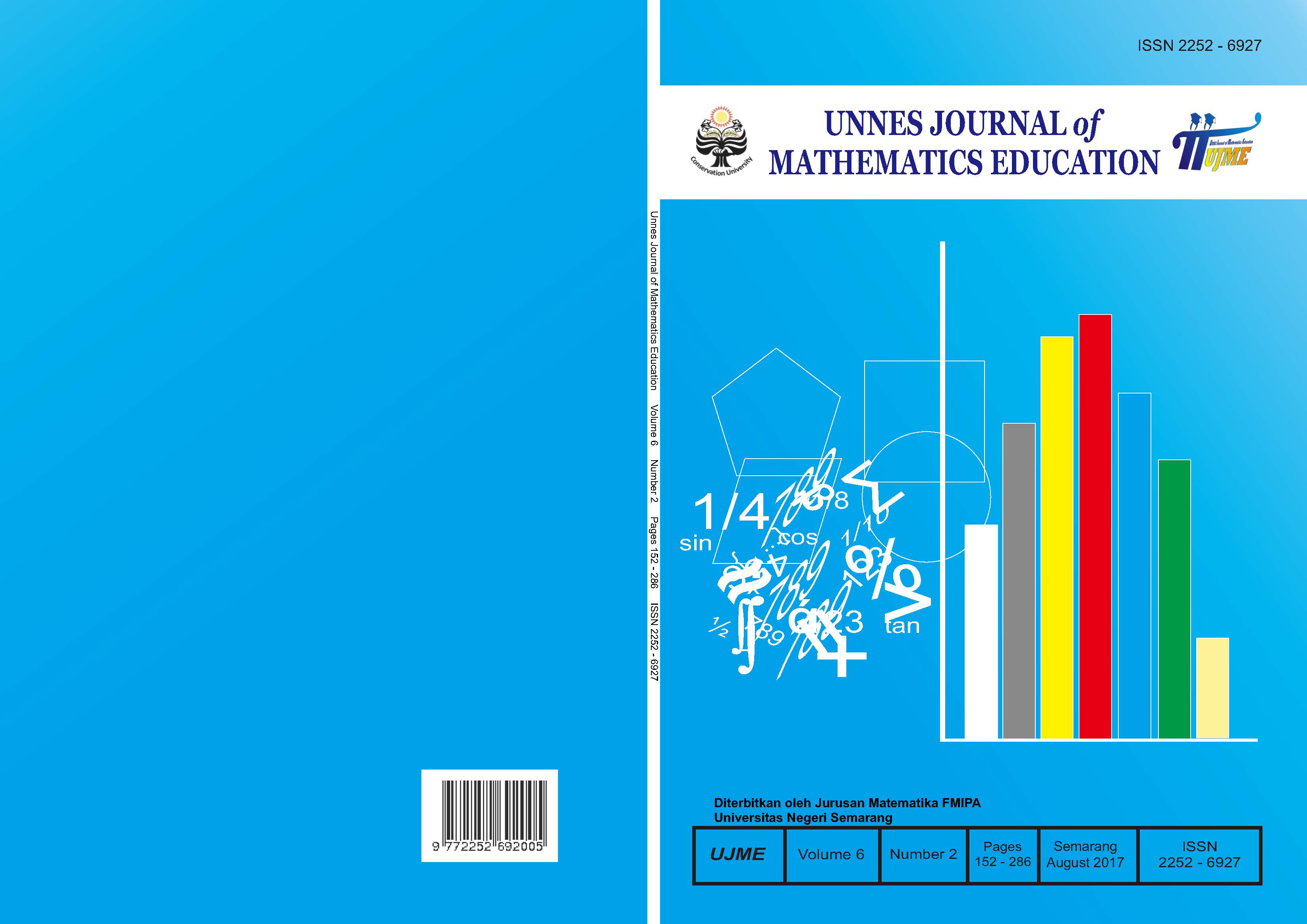Analysis of Mathematical Connection Ability and Mathematical Disposition Students of 11th Grade Vocational High School
##plugins.themes.academic_pro.article.main##
Abstract
The purpose of this research was to described mathematical connection ability, mathematical disposition students of eleventh grade Vocational High School. This research also was to described mathematical connection ability reviewed by mathematical disposition and mathematical disposition reviewed by mathematical connection ability. The social situation was students of eleventh grade Eight Vocational High School. The subject in this research was students in the level of capacity to mathematical connection ability and mathematical disposition was three students in XI RPL 2 Eight State Vocational High School of Semarang. The result showed a description (1) mathematical connection ability level of students were medium; (2) mathematical disposition level of students were medium; (3) students had high mathematical connection ability level tendency to construct mathematical disposition level better than students had medium and low mathematical connection ability level; (4) students had high mathematical disposition level tendency to construct mathematical connection ability level better than students had medium and low mathematical disposition level.
##plugins.themes.academic_pro.article.details##
References
Azwar, S. (2010). Penyusunan Skala Psikologi Edisi II. Yogyakarta: Pustaka Pelajar.
Killpatrick, J., Swafford, J., & Findell, B. (2011). Adding It Up: Helping Children Learn Mathematics. United States: The Nastional Academies Press.
Mandur, K., Sandra, I. W., & Suparta, I. N. (2016). Kontribusi Kemampuan Koneksi, Kemampuan Representasi, dan Disposisi Matematis Terhadap Prestasi Belajar Matematika Siswa SMA Swasta Di Kabupaten Manggarai. Jurnal Pendidikan dan Kebudayaan Misio, 8(1), 65-72.
Moleong, L. J. (2010). Metodologi Penelitian Kualitatif. Bandung: PT Remaja Rosdakarya.
Mousley, J. (2004). An Aspect of Mathematical Understanding The Notion of Connected Knowing. Proceeding of the 28th Conference of the International Group for the Psycology of Mathematics Education, 3(1), 377-384.
NCTM. (2000). Principle and Standards for School Mathematics. Reston, VA: NCTM.
OECD. (2016). PISA 2015: Results In Focus.
Provasnik, S., Kastberg, D., Ferraro, D., Lemanski, N., Roey, S., & Jenkins, F. (2016). Highlights From TIMSS and TIMSS Advanced 2015: Mathematics and Science Achievement of U.S Students in Grade 4 and 8 and in Advanced Courses at the End of High School in an International Context. Washington, DC: National Center for Education Statistics, Intitute of Education Sciencesm U.S. Department of Education.
Rahayu, R., & Kartono. (2014). The Effect of Mathematical Disposition toward Problem Solving Ability Based On IDEAL Problem Solver. International Journal of Science and Research, 10(3), 1315-1318.
Rohendi, D. (2012). Developing E-Learning Based on Animation Content for Improving Mathematical Connection Abilities in High School Students. International Journal of Computer Science Issues, 9(1), 1-5.
Rohendi, D., & Dulpaja, J. (2013). Connected Mathematics Project (CMP) Model Based on Presentation Media to the Mathematical Connection Ability of Junior High School Student. Journal of Education and Practice, 4(4), 17-22.
Saminanto, & Kartono. (2015). Analysis of Mathematical Connection Ability In Linear Equation With ONE Variable Based On Connectivity Theory. International Journal of Education and Research, 4(3), 259-270.
Sapto, A. D., Suyitno, H., & Susilo, B. E. (2015). Keefektifan Pembelajaran Strategi React Dengan Model SSCS Terhadap Kemampuan Komunikasi Matematika dan Percaya Diri Siswa Kelas VII. Journal of Mathematics Education, 4(3), 223-229.
Sugiyono. (2009). Metode Penelitian Kuantitatif, Kualitatif dan R&D. Bandung: CV. ALFABETA.
Sumirat, L. A. (2014). Efektifitas Strategi Pembelajaran Tipe Think-Talk-Write (TTW) Terhadap Kemampuan Komunikasi dan Disposisi Matematis SIswa. Journal Pendidikan dan Keguruan, 2(1), 21-29.
